March 21, 2008
If you haven’t seen 10,000 BC, I highly recommend you give it a second chance for your weekend viewing before it leaves the big screen.
I find it discouraging that one of the major movie criticisms being heaped on 10,000 BC is that there was not enough blood and gore, that the slicing and dicing of humans, with full-screen blood spatter, did not fill every scene. What, I must ask, is wrong with old-fashion storytelling?
10,000 BC is a movie that will grow on people as viewers take in what they have in front of them. It is an elegant, sweeping, majestic mythical movie set on a grand scale. The film literally is a prehistoric cinematic comic book, an adventure journey, slowly unfolding before you.
10,000 BC reminded me of my best experiences I had reading old Classics Illustrated and similar comics, after sometimes reading one of the books they were based upon or sometimes not. Those comics opened worlds for me [and, yes, perhaps even helped with a couple book reviews (come on, you must know they served as early “Cliff Notes”)].
Frankly, bottomline, the potential possibility of future wonder in this movie is being underestimated.

May 1957, Classics Illustrated #138 ~ A Journey to the Center of the Earth by Jules Verne (artist Norm Saunder’s first of only five painted covers for this title).
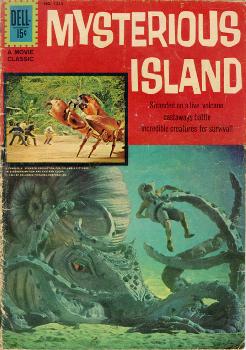
I predict 10,000 BC will grow on people. After folks let the movie’s legendary quests sweep over them, as DVD buyers watch the HD version, the merging shoots from the Nubian desert, the South African jungles, and the New Zealand mountains will be seen to work. In a few months, you will hear more about the good tale that this movie shares. And you will regret you let it leave the theaters without seeing it up there on the large screen.
Now to the animals….
As far as computer-generated mammoths, the saber-toothed tiger, and the terror birds, they are some of the most seamless adaptations I have ever viewed in a contemporary film.
For those that feel there is a problem with mammoths existing during the timeline of 10,000 BC, unfortunately those critics seem unaware of cave drawings, fossil finds, and evidence that humans and mammoths coexisted until around 2500 B.C. A small population survived on St. Paul Island, Alaska, up until 6000 B.C. and the small mammoths of Wrangel Island became extinct only around 2000 B.C. Those times are amazingly close to now.
Some critics of 10,000 BC have complained about the editing of the scenes of fighting between the terror birds and the humans, saying the birds moved too quickly. I actually thought the encounters worked. It recalled for me how I often “see” animals. First there is a blur, then I focus on what I’m viewing, and finally the animals I am trying to watch come into clearer view. My experience of the movie’s terror birds was taken in along those lines.
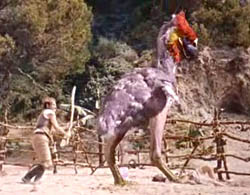
Sure, the stop-action terror birds of the old film, Mysterious Island are pretty cool. But for a truer sense of reality, indeed, 10,000 BC’s ancient birds show us more correctly that these animals are nothing more than evolved feathered dinosaurs.
Terror birds were first discovered in the late 1800s and are believed to have become South America’s top predators after the dinosaurs died off 65 million years ago.
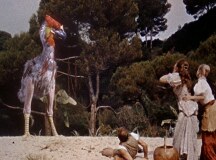
When 10,000 BC was being scripted and filmed, it appears obvious, the new findings (since overturned) were just hitting the peer-reviewed scholarly journals and the mainstream media that species of terror birds from Texas had been dated to, humm, 12,000 Before Present, or, well, 10,000 B.C.
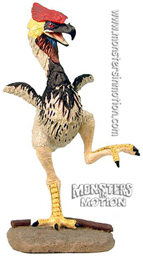
This model (above) of the Mysterious Island’s Terror Bird from MonstersInMotion.com still is on my wish list for the museum, but I now must wonder, will 10,000 BC have replica Terror Birds and Mammoths?
Dinosaurs do live on today and they are birds. 10,000 BC’s images of the terror birds gives viewers an indication of how these dinosaurlike birds might have ruled their day.

An artist’s rendering of the 2003 discovered new species of phorusrhacid, or terror bird, shows the massive creature’s sharp, curving beak. A high school student unearthed the ancient remains of the new species in the Patagonia region of Argentina. The fossil skull of the new specimen ~ the largest bird the world has ever seen ~ is viewed in the bottom photo alongside a modern California condor skull, is 2.3 feet (almost a meter) long and represents the largest bird skull ever found.
Skulls photograph by S. Bertelli, illustration by S. Abramowicz.
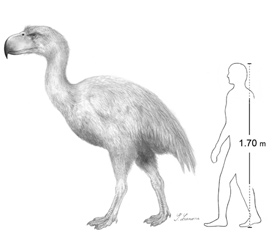
An illustration shows the size of a large terror-bird species compared to that of an average-size human. The extinct group of predatory, flightless birds dominated South America from 65 million to 2.5 million years ago.
Illustration by Gustavo Lecuona
About Loren Coleman
Loren Coleman is one of the world’s leading cryptozoologists, some say “the” leading living cryptozoologist. Certainly, he is acknowledged as the current living American researcher and writer who has most popularized cryptozoology in the late 20th and early 21st centuries.
Starting his fieldwork and investigations in 1960, after traveling and trekking extensively in pursuit of cryptozoological mysteries, Coleman began writing to share his experiences in 1969. An honorary member of Ivan T. Sanderson’s Society for the Investigation of the Unexplained in the 1970s, Coleman has been bestowed with similar honorary memberships of the North Idaho College Cryptozoology Club in 1983, and in subsequent years, that of the British Columbia Scientific Cryptozoology Club, CryptoSafari International, and other international organizations. He was also a Life Member and Benefactor of the International Society of Cryptozoology (now-defunct).
Loren Coleman’s daily blog, as a member of the Cryptomundo Team, served as an ongoing avenue of communication for the ever-growing body of cryptozoo news from 2005 through 2013. He returned as an infrequent contributor beginning Halloween week of 2015.
Coleman is the founder in 2003, and current director of the International Cryptozoology Museum in Portland, Maine.
Filed under Breaking News, Cinema News, Cryptofiction, Cryptomundo Exclusive, Cryptotourism, CryptoZoo News, Cryptozoologists, Cryptozoology, Living Dinosaurs, Movie Monsters, Replica Cryptia, Winged Weirdies